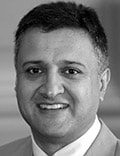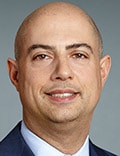If someone has been in cardiac arrest for 10 minutes, the brain is permanently damaged and there's nothing to do, right?
Not so according to emerging evidence that suggests that the brain shows signs of electrical recovery for as long as an hour into ongoing cardiopulmonary resuscitation (CPR). This time between cardiac arrest and awakening can be a period of vivid experiences for the dying patient before they return to life — a phenomenon known as "recalled death."
Sam Parnia, MD, PhD
The whole point is that these people are not near death. They actually died and came back from it.
This should be an impetus to increase the use of devices that measure the quality of CPR and to find new treatments to restart the heart or prevent brain injury, experts advised. Cardiologists and critical care clinicians are among those who will need to manage patients in the aftermath.
"If people who go into cardiac arrest receive good quality chest compressions that restore blood flow to the brain, then consciousness is restored, as well," said Jasmeet Soar, MD, consultant in Anesthetics & Intensive Care Medicine, North Bristol NHS Trust, Bristol, England, and an editor of the journal Resuscitation.

"We know that because if chest compressions are stopped, the person becomes unconscious again," he told theheart.org | Medscape Cardiology. "This CPR-induced consciousness has become more common when professionals do the CPR because resuscitation guidelines now place a much bigger focus on high-quality CPR — 'push hard, push fast.'"
"People are giving up too soon on trying to revive individuals, and they should be trying more modern strategies, such as extracorporeal membrane oxygenation," Sam Parnia, MD, PhD, associate professor in the Department of Medicine at NYU Langone Health and director of critical care and resuscitation research at NYU Langone, New York City, told theheart.org | Medscape Cardiology.

Brain Activity, Heightened Experiences
Two types of brain activity may occur when CPR works. The first, called CPR-induced consciousness, is when an individual recovers consciousness while in cardiac arrest. Signs of consciousness include combativeness, groaning, and eye-opening, Soar explained.
The second type is a perception of lucidity with recall of events, he said. "Patients who experience this may form memories that they can recall. We're not sure whether that happens during CPR or while the patient is waking up during intensive care, or how the brain creates these memories, or if they're real memories or coincidental, but it's clear the brain does form them during the dying and recovery process."
This latter phenomenon was explored in detail in a recent study led by Parnia.
In that study of 567 in-hospital patients with cardiac arrest from 25 centers in the United States and United Kingdom, 53 survived, 28 of those survivors were interviewed, and 11 reported memories or perceptions suggestive of consciousness.
Four types of experiences occurred:
- Recalled experiences of death: "I thought I heard my grandma [who had passed] saying 'you need to go back.'"
- Emergence from coma during CPR/CPR-induced consciousness: "I remember when I came back and they were putting those two electrodes to my chest, and I remember the shock."
- Emergence from coma in the post-resuscitation period: "I heard my partner saying [patient's name] and my son saying 'mom.'"
- Dreams and dream-like experiences: "[I] felt as though someone was holding my hand. It was very black; I couldn't see anything."
In a complementary cross-sectional study, 126 community cardiac arrest survivors reported similar experiences plus a fifth type, "delusions," or "misattribution of medical events," for example, "I heard my name, over and over again. All around me were things like demons and monsters. It felt like they were trying to tear off my body parts."
"Many people label recalled experiences of death as 'near-death' experiences, but they're not," Parnia said. "Medically speaking, being near to death means your heart is about to stop. But the whole point is that these people are not near death. They actually died and came back from it."
One of the big implications of the study, he said, is that "a lot of physicians are taught that somehow after, say, 3-5 minutes of oxygen deprivation, the brain dies. Our study showed this is not true. It showed that the brain may not be functioning, which is why they flatline. But if you're able to resuscitate them appropriately, you can restore activity up to an hour later."
Because some clinicians questioned or dismissed previous work in this area by Parnia and others, the latest study used EEG monitoring in a subset of 53 patients. Among those with evaluable EEG data, brain activity returned to normal or near-normal after flatlining in about 40% of images; spikes were seen in the delta (22%), theta (12%), alpha (6%), and beta (1%) waves associated with higher mental function.
"The team recorded what was happening in the brain during real-time CPR using various tests of consciousness, including EEG measurements and tests of visual and auditory awareness using a tablet with a special app and a Bluetooth headphone."
"Incredibly, we found that even though the brain flatlines, which is what we expect when the heart stops, with professionally given CPR even up to about an hour after this, the brainwaves changed into normal to near-normal patterns," Parnia said. "We were able to identify these brain waves in patients while they were being resuscitated, which confirms the fact that people can have lucid consciousness even though they appear to be unconscious."
Asked what implications, if any, his work has for current definitions of brain death and cardiac death, Parnia said that the problem is that these are based on the concept of "a permanent irreversible loss of function," but "that's only relative to what medical treatments are developed at a given time."
Potential Mechanism
Parnia and his team proposed a potential mechanism for recalled experiences of death. Essentially, when the brain flatlines, the dying brain removes natural inhibitory (braking) systems that are needed to support daily functioning. This disinhibition may open access to "new dimensions of reality, including lucid recall of stored memories from early childhood to death," he said.
From a clinical perspective, he noted, "although the brain stops working when it flatlines, it does not die within 5 or 10 minutes of oxygen deprivation."
This is contrary to what many doctors believe, and because of that, he said, "nobody has tried to find treatments or new ways to restart the heart or prevent brain injury. They think it's futile. So, with this work, we've opened up the window to developing cocktails of drugs that could be given to patients who have technically gone through death to bring them back to life again."
Probe Patients or Leave Well Enough Alone?
The findings have ramifications for clinicians who may be caring for patients who survive cardiac arrest, said Lance B. Becker, MD, professor and chair, Department of Emergency Medicine, Donald & Barbara Zucker School of Medicine at Hofstra/Northwell, Manhasset, New York, and chair, Department of Emergency Medicine at North Shore University Hospital, Manhasset, and Long Island Jewish Medical Center, Queens, New York.
"I've talked with a lot of patients who have had some kind of recalled experience around cardiac arrest and some who have had zero recall, as well, like in the paper," he told theheart.org | Medscape Cardiology. "The ones who do have an experience are sometimes mystified by it and have questions. And very often, clinicians don't want to listen, don't think it's important, and downplay it."
"I think it is important, and when people have important things happen to them, it's really imperative that doctors listen, learn, and respond," he said. "When I started in this field a long time ago, there were so few survivors that there wasn't even a concept of survivorship," he said.

Becker noted that it's not uncommon for cardiac arrest survivors to have depression, problems with executive function, or a small brain injury they need to recover from. "Now survivorship organizations are springing up that these people can turn to, but clinicians still need to become more aware and sensitive to this."
Not all are. "I had a number of patients who said I was the only doctor who ever asked them about what they experienced," he recalled. "I was a young doctor at the time and didn't exactly know what to say to them, but they were just happy to have a doctor who would listen to them and not be afraid to hear what they had to say."
Recognizing that support is an issue, the American Heart Association released a scientific statement in 2020 on sudden cardiac arrest survivorship, which "expands the cardiac arrest resuscitation system of care to include patients, caregivers, and rehabilitative healthcare partnerships, which are central to cardiac survivorship."
Soar has a more nuanced view of survivorship support, however. "I suspect some people are very glad to be alive, and that trying to dig deep and bring things out may actually be harmful," he said. "It's not as clear cut as everybody thinks."
He noted that follow-up and rehabilitation should be an option for people who specifically need it who would need to be identified. "But human beings are resilient, and while some people will require help, not everybody will," he said.
Better CPR, New Treatments
Experts in emergency and intensive care medicine studying survival after cardiac arrest hope to find ways to save patients before too much damage is done to the brain and other organs from loss of oxygen, Parnia said. He is the lead author in a recent multidisciplinary consensus statement on guidelines and standards for the study of death and recalled experiences of death.
"One of my bugbears is that our survival outcomes from cardiac arrest resuscitation have not changed very much for 60 years because we haven't developed new treatments and innovative methods," he said. "Unlike the rest of medicine, we're living in the past."
Currently, his team is developing cocktails of treatments. These include hypothermic circulatory arrest — cooling the body to stop blood circulation and brain function for up to 40 minutes — and giving magnesium, a brain-protective treatment, to people whose hearts stop.
Becker would like to see optimal care of patients with cardiac arrest. "The first step is to increase blood flow with good CPR and then measure whether CPR is working," he said. Adding that despite the availability of devices that provide feedback on the quality of CPR, they're rarely used. He cited ultrasound devices that measure the blood flow generated during CPR, compression meter devices that go between the patient's chest and the rescuer's hands that gauge the rate and depth of compression, and invasive devices that measure blood pressure during CPR.
His group is trying to design even better devices, he said. "An example would be a little probe that you could pop on the neck that would study blood flow to the brain with ultrasound, so that while you were pumping on the person, you could see if you're making them better or not."
"We also have some preliminary data showing that the American Heart Association recommended position on the chest for doing CPR is not the perfect place for everybody," he said. The 2020 AHA guidelines recommended the center of the lower half of the sternum. At the 2023 American College of Emergency Physicians meeting, Becker's team at Hofstra/Northwell presented data on 175 video-recorded adult cardiac arrests in their emergency department over more than 2 years, 22 of which involved at least one change of compression location (for a total of 29 location changes). They found that 41% of compression location changes were associated with return of spontaneous circulation.
For about a third of people, the hands need to be repositioned slightly. "This is not anything that is taught to the public because you can only figure it out if you have some kind of sensor that will let you know how you're doing. That's very achievable. We could have that in the future on every ambulance and even in people's homes."
When the person arrives at the hospital, he said, "we can make it easier and more likely that they can be put on extracorporeal membrane oxygenation (ECMO). We do that on selected patients in our hospital, even though it's very difficult to do, because we know that when it's done properly, it can change survival rates dramatically, from maybe 10%-50%."
Becker, like Parnia, also favors the development of drug cocktails, and his team has been experimenting with various combinations in animal models. "We think those two things together — ECMO and a drug cocktail — would be a very powerful one to two knock out for cardiac arrest," he said. "We have a long way to go — 10 or 20 years. But most people around the world working in this area believe that will be the future."
Parnia's study on recalled death was supported by The John Templeton Foundation, Resuscitation Council (UK), and New York University Grossman School of Medicine, with research support staff provided by the UK's National Institutes for Health Research. Soar is the editor of the journal Resuscitation and receives payment from the publisher Elsevier. Becker's institute has received grants from Philips Medical Systems, NIH, Zoll Medical Corp, Nihon Kohden, PCORI, BrainCool, and United Therapeutics. He has received advisory/consultancy honoraria from NIH, Nihon Kohden, HP, and Philips, and he holds several patents in hypothermia induction and reperfusion therapies and several pending patents involving the use of medical slurries as human coolant devices to create reperfusion cocktails and measurement of respiratory quotient. Follow Marilynn Larkin on X: @MarilynnL

